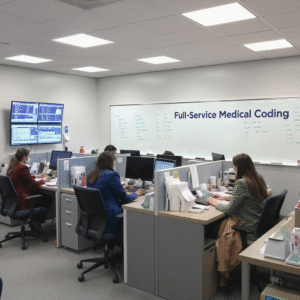How Technology is Improving Medical Billing Accuracy: A Revolution in Healthcare Administration
Medical Billing Accuracy
Medical Billing Accuracy
Medical billing has long been one of the most challenging aspects of healthcare administration. With complex coding systems, ever-changing regulations, and the pressure to process claims quickly and accurately, healthcare providers have struggled with billing errors that cost the industry billions of dollars annually. However, the tide is turning as innovative technologies are transforming how medical billing is handled, dramatically improving accuracy rates and streamlining the entire process.

The Current State of Medical Billing Challenges
Before diving into technological solutions, it’s crucial to understand the magnitude of the problem. The American Medical Association estimates that healthcare providers lose approximately $125 billion annually due to billing errors and claim denials. These errors don’t just impact the bottom line – they also delay patient care, create administrative burdens, and contribute to the overall inefficiency of the healthcare system.
Traditional medical billing processes have been plagued by human error, with studies showing that manual data entry can have error rates as high as 1-3%. When you consider that a typical medical practice processes thousands of claims annually, even a small error rate can result in significant financial losses and operational disruptions.
Common billing errors include incorrect patient information, wrong procedure codes, missing documentation, duplicate charges, and mismatched insurance information. These seemingly minor mistakes can lead to claim rejections, delayed payments, and the need for costly resubmissions that tie up administrative resources.
Artificial Intelligence and Machine Learning: The Game Changers
Artificial intelligence and machine learning technologies are at the forefront of revolutionizing medical billing accuracy. These sophisticated systems can analyze vast amounts of data, identify patterns, and make predictions with remarkable precision, far exceeding human capabilities in many areas.
AI-powered billing systems can automatically review claims before submission, flagging potential errors and inconsistencies. Machine learning algorithms continuously improve their accuracy by learning from historical data, identifying common error patterns, and adapting to new billing scenarios. This proactive approach catches mistakes before they become costly claim denials.
One of the most significant advantages of AI in medical billing is its ability to cross-reference multiple data sources simultaneously. These systems can verify patient insurance eligibility in real-time, check for coding accuracy against the latest medical coding standards, and ensure that all required documentation is complete and properly linked to the appropriate procedures.
Natural language processing, a subset of AI, is particularly valuable in extracting relevant information from physician notes and converting them into accurate billing codes. This technology can interpret complex medical terminology and translate it into the appropriate ICD-10, CPT, and HCPCS codes with remarkable accuracy, reducing the reliance on manual coding that is prone to human error.

Electronic Health Records Integration
The integration of advanced billing systems with electronic health records represents another major leap forward in billing accuracy. Modern EHR systems equipped with intelligent billing modules can automatically populate billing information based on the clinical data entered during patient encounters.
This seamless integration eliminates the need for manual data transfer between clinical and billing systems, which is a common source of errors in traditional workflows. When physicians document patient encounters in the EHR, the system can automatically suggest appropriate billing codes based on the procedures performed, diagnoses made, and treatments provided.
Advanced EHR-billing integrations also include built-in compliance checks that ensure billing practices adhere to current healthcare regulations and payer requirements. These systems can alert users to potential compliance issues before claims are submitted, reducing the risk of audits and penalties.
Robotic Process Automation in Billing Workflows
Robotic Process Automation has emerged as a powerful tool for improving the accuracy and efficiency of repetitive billing tasks. RPA systems can handle routine processes such as patient registration, insurance verification, claim preparation, and follow-up activities with minimal human intervention.
These automated systems work around the clock, processing claims with consistent accuracy and eliminating the fatigue-related errors that can occur with manual processing. RPA can also handle the tedious task of checking claim status with multiple payers, automatically resubmitting corrected claims, and updating patient accounts with payment information.
The beauty of RPA lies in its ability to follow predefined rules and workflows with perfect consistency. Once programmed, these systems execute billing processes exactly the same way every time, eliminating the variability that comes with human processing and significantly reducing error rates.
Real-Time Eligibility Verification and Prior Authorization
One of the most frustrating aspects of traditional medical billing has been discovering after the fact that a patient’s insurance coverage had changed or that prior authorization was required for a procedure. Modern technology addresses this challenge through real-time eligibility verification systems that check patient coverage status at the point of service.
These systems connect directly with insurance payers’ databases to verify coverage, co-pay amounts, deductible status, and any specific requirements for the planned procedures. This real-time verification prevents many common billing errors and ensures that patients are properly informed about their financial responsibilities before receiving care.
Automated prior authorization systems have also streamlined what was once a time-consuming manual process. These systems can automatically submit prior authorization requests with all required documentation, track approval status, and alert staff when authorizations are approved or additional information is needed.

Advanced Analytics and Predictive Modeling
Healthcare organizations are leveraging advanced analytics to identify billing patterns, predict potential issues, and optimize their revenue cycle management. These analytical tools can identify trends in claim denials, pinpoint specific payers or procedure types that frequently result in billing problems, and provide actionable insights for improving overall billing performance.
Predictive modeling takes this analysis a step further by forecasting potential billing issues before they occur. These models can analyze historical data to predict which claims are most likely to be denied, allowing billing staff to review and correct potential problems proactively.
Revenue cycle analytics also help healthcare organizations optimize their billing workflows by identifying bottlenecks, measuring staff productivity, and tracking key performance indicators such as days in accounts receivable, first-pass resolution rates, and overall collection percentages.
Cloud-Based Solutions and Interoperability
Cloud-based billing platforms have revolutionized how healthcare organizations manage their billing operations. These solutions offer several advantages over traditional on-premise systems, including automatic updates to coding standards and payer requirements, scalable processing capacity, and enhanced security features.
Cloud platforms also facilitate better interoperability between different healthcare systems and stakeholders. Billing information can be easily shared between providers, payers, and patients through secure, standardized interfaces that reduce errors associated with manual data transfer.
The ability to access billing systems from anywhere with an internet connection has also improved the flexibility and efficiency of billing operations, allowing staff to work remotely and ensuring that billing processes can continue even during disruptions to normal operations.
Blockchain Technology for Billing Transparency
While still in its early stages of adoption, blockchain technology shows promise for improving medical billing accuracy through enhanced transparency and data integrity. Blockchain can create an immutable record of all billing transactions, making it easier to track the complete lifecycle of a claim and identify where errors occur.
This technology could also facilitate more efficient communication between healthcare providers and payers by creating a shared, transparent ledger of all billing activities. Such transparency could reduce disputes, speed up claim processing, and improve overall accuracy by ensuring all parties have access to the same, unalterable information.
The Human Element: Technology-Assisted, Not Technology-Replaced
While technology is dramatically improving medical billing accuracy, it’s important to note that the human element remains crucial. The most successful implementations combine advanced technology with skilled billing professionals who can handle exceptions, make complex decisions, and ensure that the technology is being used effectively.
Technology serves as a powerful assistant to human billers, handling routine tasks with perfect accuracy while flagging unusual situations that require human judgment. This combination of technological precision and human expertise creates the optimal environment for achieving the highest levels of billing accuracy.

Looking Ahead: The Future of Medical Billing Technology
The future of medical billing technology looks incredibly promising, with emerging technologies such as quantum computing, advanced AI models, and enhanced interoperability standards poised to further improve accuracy and efficiency. These advancements will likely make medical billing even more automated, accurate, and transparent.
As these technologies continue to evolve, we can expect to see even higher levels of billing accuracy, faster claim processing times, and reduced administrative costs. The ultimate goal is a healthcare system where billing is so accurate and efficient that it becomes largely invisible to both providers and patients, allowing everyone to focus on what matters most: delivering quality healthcare.
The transformation of medical billing through technology represents one of the most significant improvements in healthcare administration in recent decades. As these technologies continue to advance and become more widely adopted, the entire healthcare industry will benefit from improved accuracy, reduced costs, and more efficient operations that ultimately lead to better patient care and outcomes.
Why we bill
Going to the doctor may seem like a one-to-one interaction, but in reality it’s part of a large, complex system of information and payment. While the insured patient may only have direct interaction with one person or healthcare provider, that check-up is actually part of a three-party system.
The first party is the patient. The second party is the healthcare provider. The term ‘provider’ includes hospital, physicians, physical therapists, emergency rooms, outpatient facilities, and any other place where medical services are performed. The third and final party is the insurance company, or payer.
It’s the medical biller’s job to negotiate and arrange for payment between these three parties. Specifically, the biller ensures that the healthcare provider is compensated for their services by billing both patients and payers. We bill because healthcare providers need to be compensated for the services they perform.
In order to do this, the biller collects all of the information (found in a “superbill”) about the patient and the patient’s procedure, and compiles that into a bill for the insurance company. This bill is called a claim, and it contains a patient’s demographic information, medical history, and insurance coverage, in addition to a report on what procedures were performed and why.
More about Insurance
Let’s take a quick step back to talk briefly about the insurance process. Health insurance is insurance against medical expenses. Put simply, people with health insurance, sometimes called ‘the insured’ or ‘subscribers,’ pay a certain amount in order to have a degree of protection against medical costs.
Health insurance comes in a number of forms, including:
- Indemnity, or pay-for-service insurance, in which the patient may choose any provider they like. This insurance is typically costlier, but grants the insured person more flexibility. As healthcare prices rise, indemnity insurance is becoming less and less popular.
- Managed care organizations (MCO): This is a blanket term that includes organizations like Healthcare Maintenance Organizations (HMOs) and Preferred Provider Organizations (PPOs). Patients have fewer options as to which providers they can see, but their premiums and deductibles are fixed and are generally lower. Essentially, managed care insurance restricts patient’s options but also lowers the cost of having health insurance. This is the most popular form of health insurance in the United States today.
- Consumer-driven health plans
- We’ll look more at health insurance in just a bit, and we’ll look even deeper into the insurance claims process later on.
With each of these types of insurance, there are procedures and services that are covered, and some that are not. It’s the medical biller’s job to interpret a patient’s insurance plan (or plans) and use this information to create an accurate claim.
More About Claims
The creation of the claim is where medical billing most directly overlaps with medical coding. Medical billers take the procedure and diagnosis codes used by medical coders and use them to create claims.
Procedure codes, whether Current Procedure Terminology (CPT) or Healthcare Common Procedure Coding System (HCPCS), tell the payer what service the healthcare provider performed. Diagnosis codes, documented using ICD codes, demonstrate medical necessity. In other words, procedure codes tell the what of a patient’s visit, and the diagnosis codes tell the why.
The biller adds information about the patient and the patient’s visit, along with the cost of the procedure or procedures performed, to the claim. So the claim now has a what, a why, a who, a when, and a how much.
At this point, the biller also checks to make sure a claim is compliant. That is, the claim is factually and formally correct. This is a complicated process, as the biller must know what the claim allows so that the payer can fully evaluate the procedure and decide how much they will reimburse the provider. If the claim is approved, it’s sent back to the biller with the amount the payer is going to pay. The biller then takes the amount, called the balance, and sends it on to the patient.
Day-to-Day Activities
Now that you’ve got a little more information about the overall process, here’s a quick look at the day-to-day activities of a professional medical biller.
Working with Patients
- When a patient receives medical services from a healthcare provider, they’re typically presented with a bill at the end of their services. The biller creates this bill by looking at the balance (if any) the patient has, adding the cost of the procedure or service to that balance, deducting the amount covered by insurance, and factoring in a patient’s copay or deductible.
- Billers also work daily with a patient’s medical records. Where coders use medical reports to accurately translate medical services into code, billers abstract information from patients’ medical records and insurance plans to create accurate medical bills.
Working with Computers
- Today, almost every doctor’s office in the country uses some form of practice management software. This software keeps track of patients, helps schedule visits, stores important medical information and generally helps the practice run smoothly.
Creating Claims
- The majority of a medical biller’s day is spent creating and processing medical claims. Billers need to be familiar with what type of claim an insurance payer accepts, and adjust their claim creation accordingly. Billers may also work frequently with insurance clearinghouses to streamline the claims process. Billers also have to check that each claim is compliant. Ideally, every claim a biller sends out will be “clean.” A clean claim contains no errors, and will be processed speedily by the payer, ensuring that the healthcare provider gets reimbursed quickly and efficiently.
Notification and Communication
- A biller is constantly in communication with insurance payers, clearinghouses, providers, and patients. Since the biller acts as the waypoint for the reimbursement process, they frequently have to clarify and follow-up with all parties of the healthcare process.
- Billers also explain and notify patients of their bill. Billers are in charge of issuing Explanations of Benefits (EOBs) to patients, which list which procedures are covered by the payer and why.
- Billers must also follow up with patients about paying the balance on their medical bills.
Collections
- In the case of a patient with delinquent bills, a medical billing specialist may have to arrange for collections on that debt. This is not necessarily a “day-to-day” activity, as one would hope that a provider’s patients were not ignoring their medical bills on a daily basis, but it is something to be aware of.



